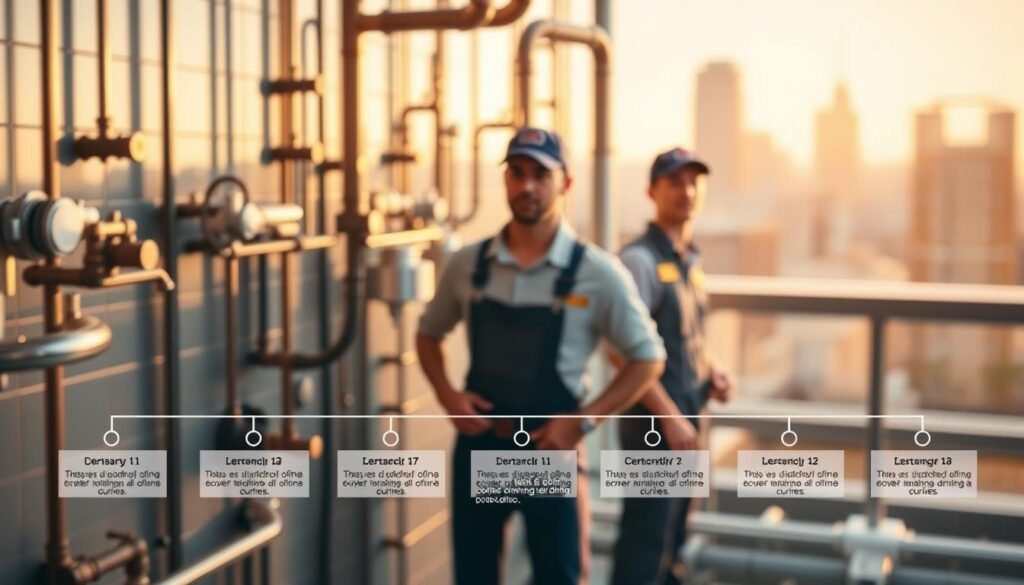Ever wondered why plumbing remains one of the most stable career choices? With a projected 7% job growth, this trade offers job security and solid earning potential. But the path to becoming a skilled professional isn’t the same for everyone.
Apprenticeships typically last 4-5 years, while trade school programs can be completed in 1-2 years. Some accelerated courses even wrap up in just 12-16 weeks. Licensing prep adds another 6-12 months, depending on state requirements.
Factors like education route, specialization, and local regulations impact the timeline. Whether you choose hands-on training or classroom learning, the journey is rewarding. Let’s break down the steps to help you plan your future in this essential trade.
Key Takeaways
- Apprenticeships usually take 4-5 years to complete.
- Trade school programs range from 1-2 years, with accelerated options available.
- Licensing preparation adds 6-12 months to the process.
- State requirements and specialization influence the overall timeline.
- The plumbing industry is growing, with a 7% projected job increase.
Introduction to a Plumbing Career
The plumbing industry offers unmatched stability in today’s job market. Worth $124 billion in the U.S., it thrives on constant demand for essential services. From fixing leaks to installing systems, plumbers keep homes and businesses running smoothly.
Median pay for plumbers hits $60,090 annually, with 48,000 job openings projected yearly. Unlike many fields, this trade resists automation, ensuring long-term work security. Whether in residential homes or industrial complexes, skilled professionals are always needed.
Career paths vary widely. Some focus on emergency repairs, while others specialize in green plumbing or smart home systems. The industry’s growth creates opportunities for innovation and entrepreneurship.
Plumbers enjoy flexible schedules and hands-on problem-solving. No two days are the same, making it ideal for those who dislike desk jobs. With training, dedication, and licensing, this career builds a brighter future.
Educational Prerequisites for Plumbers
Starting a plumbing career begins with meeting basic educational requirements. A high school diploma or GED is mandatory for all apprenticeship programs and trade schools. States like Florida explicitly require this credential for entry into vocational training.
High School Diploma or GED
This foundational credential proves essential for mastering technical skills. Math proficiency is critical for calculating pipe measurements and water pressure. Shop classes also build mechanical aptitude, a must-have for hands-on work.
Recommended High School Courses
Algebra and physics provide the analytical backbone for plumbing tasks. Technical drawing classes help blueprint reading, while computer skills prepare for modern CAD systems. First aid or OSHA safety certifications add a competitive edge.
Strong education in these areas accelerates training success. Whether pursuing apprenticeships or trade school, these prerequisites pave the way for a thriving career.
How Long Does It Take to Become a Plumber? Key Pathways
Trade schools offer a fast-track option for entering the plumbing industry. These programs compress training into 1-2 years, with accelerated courses like NTIT’s 12-16 week intensives. Hands-on labs and IPC code training prepare students for real-world challenges.

Trade School Programs
Costs range from $1,250 to $15,000, but financial aid can ease the burden. Unlike apprenticeships, students pay tuition but gain structured learning. Hybrid models combine classroom theory with fieldwork for balanced skill development.
Core coursework covers blueprint reading, fixture installation, and safety protocols. Many schools allow credit transfers toward apprenticeship hours, saving time. Graduates often qualify for entry-level roles while pursuing licensure.
Community College Advantages
Community colleges add business management courses to technical training. These programs appeal to future entrepreneurs planning to run their own services. Evening classes accommodate working professionals.
Both paths provide a critical step toward certification. Whether choosing speed or depth, trade education accelerates the journey to become plumber.
The Apprenticeship Route
Earning while training sets apprenticeships apart from other routes. This path blends paid work with structured education, typically spanning 4-5 years. Graduates emerge with licensing readiness and proven field experience.
Duration and Structure
DOL-registered programs require 144 classroom hours and 2,000 on-the-job training hours yearly. Apprentices start at 40-50% of a journeyman’s wage, with raises tied to skill milestones.
UA Local Union programs add healthcare and pension benefits. Non-union options may offer faster placement but fewer perks. Both paths culminate in a complete apprenticeship certification.
On-the-Job Training vs. Classroom Hours
Fieldwork covers pipefitting, system diagnostics, and safety protocols. Night classes focus on plumbing codes and blueprint reading. Master plumbers mentor apprentices, ensuring hands-on mastery.
Union programs often include advanced CAD training. Non-union apprenticeships prioritize immediate job-site skills. Either way, the mix of theory and practice builds versatile professionals.
State Licensing Requirements
Navigating state licensing requirements is a crucial step for plumbing professionals. Each state sets its own regulations, ensuring safety and competency standards are met. Some regions mandate statewide licenses, while others allow local jurisdictions to oversee certifications.
Exam Components: Written and Practical
The licensing exam typically includes two parts. A written test covers plumbing codes, isometric drawings, and OSHA standards. The practical portion assesses hands-on skills like pipefitting and system diagnostics.
Scores are valid for 1–2 years in most states. Applicants often prep using state-approved study guides or trade association resources. Passing both sections is mandatory for journeyman or master licensure.
Florida-Specific Example
Florida requires a $135 registration fee and a $160 testing fee. Journeyman licenses demand 4 years of experience, while master applicants need 7 years. Contractors must secure a $20,000 surety bond.
The state’s trade knowledge exam includes business law for independent contractors. Florida also offers reciprocity with Georgia and Alabama, simplifying cross-state mobility for qualified professionals.
Timeframe Breakdown: From Training to Licensure
Understanding the timeline for plumbing certifications helps plan career goals effectively. The journey from apprentice to licensed professional involves clear milestones. Each phase builds expertise while meeting state requirements.

Journeyman vs. Master Plumber Timelines
A journeyman plumber typically needs 4–5 years of combined training and experience. This includes apprenticeship hours and on-the-job practice. States like Texas require 8,000 documented work hours.
Advancing to a master plumber demands 7–10 years in the field. Additional exams test advanced skills in designing systems and managing projects. Florida mandates 7 years of experience before eligibility.
Continuing Education Needs
Licensed professionals must stay updated through continuing education. Florida requires 14 hours biennially, covering code updates and safety protocols. Digital platforms like Udemy or trade associations offer approved courses.
Specializations like medical gas or steamfitting add 6–12 months to training. NITC and IPC certifications often need renewal every 3 years. Tracking CEUs ensures compliance during license renewal cycles.
Costs of Becoming a Plumber
Investing in a plumbing career involves understanding various expenses. Training paths differ significantly in cost, affecting your budget and timeline. Smart financial planning ensures you’re prepared for both education and licensing phases.
Comparing Training Expenses
Apprenticeships typically cost $500-$2,000 for tools and books. These programs offset expenses by providing wages during training. Trade schools range from $1,250-$15,000 but require full tuition upfront.
Financial aid options like WIOA grants or FAFSA can reduce out-of-pocket cost. Some employers reimburse education fees for apprentices. Consider ROI—apprentices earn while learning, while trade school graduates start working faster.
Licensing and Business Requirements
Florida charges $209 biennially for license renewal. Master plumbers pay higher fees due to expanded business privileges. Most states require passing scores on written and practical exams.
Bond requirements add $100-$500 annually, depending on coverage. General liability insurance averages $500-$1,500 yearly. Workers’ compensation is mandatory for employees in most states.
Hidden expenses include specialized tools ($1,000+) and vehicle maintenance. Tax deductions apply for education and equipment purchases. Proper budgeting turns these investments into long-term career rewards.
Career Advancement and Specializations
The journey doesn’t end after earning a plumbing license—it evolves. Skilled professionals can boost earnings by 22% through specialized certifications. Nearly 30% of plumbers leverage these credentials to launch independent business ventures.
Green Plumbing and Niche Certifications
LEED accreditation transforms standard services into eco-friendly systems. This certification focuses on water conservation and energy-efficient installations. Demand grows as homeowners and builders prioritize sustainability.
Smart home technology offers another lucrative path. Training in IoT-enabled water monitors and leak detection systems commands premium rates. Cross-training in HVAC or electrical work expands service offerings.
Entrepreneurial Opportunities
Self-employment appeals to many in this trade. The median startup cost runs $50,000—lower than most business ventures. Franchises like Roto-Rooter provide turnkey solutions for new owners.
Municipal contract bidding requires additional skills. Mastering bid preparation and compliance documents unlocks government projects. Social media marketing helps independent plumbers stand out in local markets.
Continuing education creates these opportunities. Whether pursuing master status or niche specialties, growth potential remains strong in this essential trade.
Conclusion
The demand for skilled professionals makes this trade a smart choice today. With a 94% apprenticeship completion rate and 82% trade school employment, the path to success is clear.
Start by researching local programs or unions. Many offer hands-on training with paid work. Licensure is the final step, unlocking higher earnings and job stability.
Emerging trends like green plumbing and smart home systems add growth potential. Whether you choose apprenticeships or trade school, this career rewards dedication.
Take the first step toward becoming a licensed plumber. Explore vocational programs or apprenticeships in your area to begin your journey.
FAQ
What education is needed to start a plumbing career?
A high school diploma or GED is the minimum requirement. Courses in math, physics, and shop classes provide a strong foundation.
Can trade school speed up plumbing training?
Yes, trade school programs typically take 1-2 years, offering focused classroom and hands-on training before entering an apprenticeship.
How long does a plumbing apprenticeship last?
Most apprenticeships run 4-5 years, combining paid on-the-job training with classroom instruction on codes, safety, and systems.
What’s tested on plumbing licensing exams?
Exams include written and practical sections covering local codes, pipefitting, drainage systems, and safety regulations. Florida, for example, requires a business law exam.
What’s the difference between journeyman and master plumber?
Journeyman status requires 2-5 years of experience post-apprenticeship. Master plumbers need additional years, advanced exams, and often business training.
Are there affordable paths to becoming a plumber?
Apprenticeships often cost less than trade schools since you earn wages while learning. Licensing fees vary by state but average 0-0.
Can plumbers specialize in specific areas?
Yes, certifications in green plumbing, medical gas systems, or pipe welding can open niche opportunities and higher pay.
Do plumbers need ongoing education?
Many states require continuing education to maintain licensure, covering code updates, new technologies, and safety protocols.



